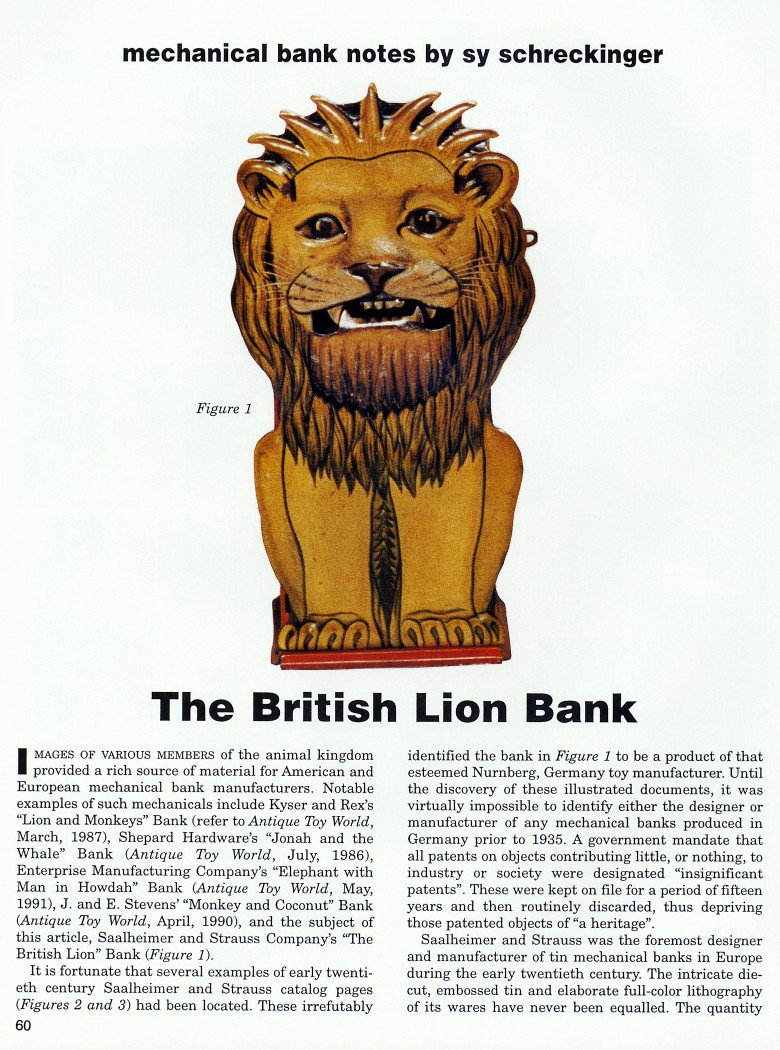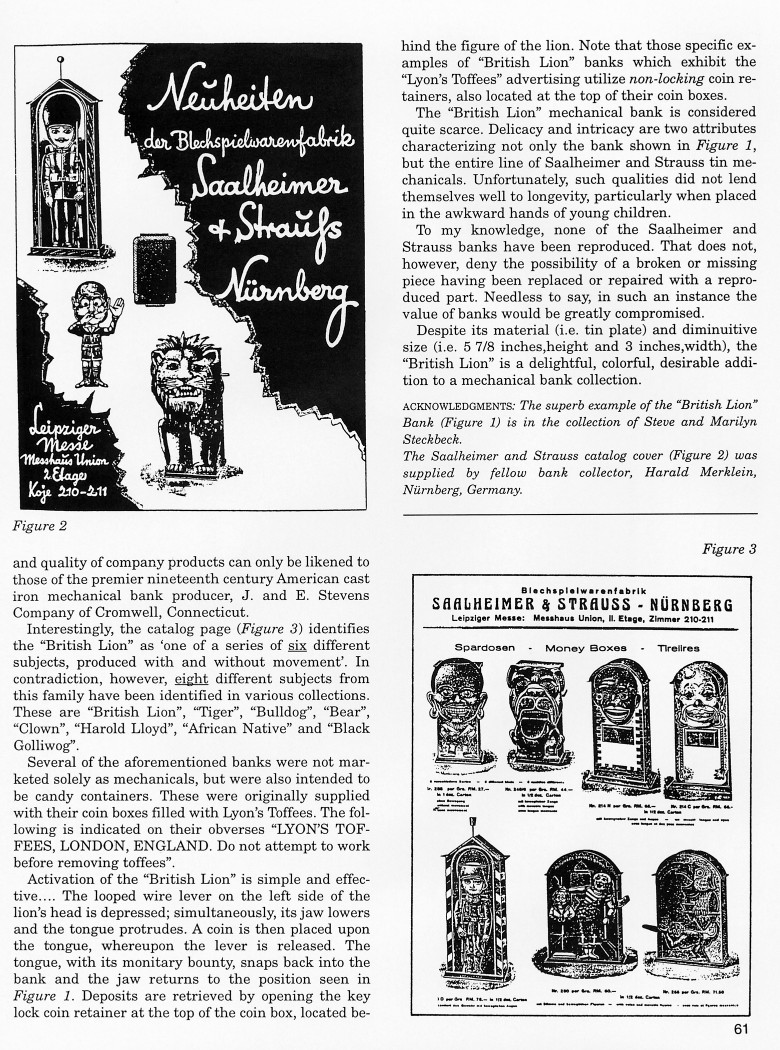|
The British Lion Bank
by Sy Schreckinger – ANTIQUE TOY WORLD Magazine – September,
1998
Images of Various members of the animal kingdom
provided a rich source of material for American and European mechanical
bank manufacturers. Notable examples of such mechanicals include Kyser and
Rex's "Lion and Monkeys" Bank (refer to Antique Toy World,
March, 1987),
Shepard Hardware's "Jonah and the Whale" Bank (Antique Toy World,
July,
1986), Enterprise Manufacturing Company's "Elephant with Man in Howdah"
Bank (Antique Toy World,
May, 1991), J. and E. Stevens' "Monkey and
Coconut" Bank (Antique Toy World,
April, 1990), and the subject of this
article, Saalheimer and Strauss Company's "The British Lion" Bank (Figure
1).
It is fortunate that several examples of early twentieth century
Saalheimer and Strauss catalog pages (Figures 2 and 3) had been located.
These irrefutably identified the bank in Figure 1 to be a product of that
esteemed Nurnberg, Germany toy manufacturer. Until the discovery of these
illustrated documents, it was virtually impossible to identify either the
designer or manufacturer of any mechanical banks produced in Germany prior
to 1935. A government mandate that all patents on objects contributing
little, or nothing, to industry or society were designated "insignificant
patents". These were kept on file for a period of fifteen years and then
routinely discarded, thus depriving those patented objects of "a
heritage".
Saalheimer and Strauss was the foremost designer and manufacturer of
tin mechanical banks in Europe during the early twentieth century. The
intricate die-cut, embossed tin and elaborate full-color lithography of
its wares have never been equaled. The quantity and quality of company
products can only be likened to those of the premier nineteenth century
American cast iron mechanical bank producer, J. and E. Stevens Company of
Cromwell, Connecticut.
Interestingly, the catalog page (Figure 3) identifies the "British
Lion" as 'one of a series of six different subjects, produced with and
without movement'. In contradiction, however, eight different subjects
from this family have been identified in various collections. These are
"British Lion", "Tiger", "Bulldog", "Bear", "Clown", "Harold Lloyd",
"African Native" and "Black Golliwog".
Several of the aforementioned banks were not marketed solely as
mechanicals, but were also intended to be candy containers. These were
originally supplied with their coin boxes filled with Lyon's Toffees. The
following is indicated on their obverses "LYON'S TOFFEES, LONDON, ENGLAND.
Do not attempt to work before removing toffees".
Activation of the "British Lion" is simple and effective.... The
looped wire lever on the left side of the lion's head is depressed;
simultaneously, its jaw lowers and the tongue protrudes. A coin is then
placed upon the tongue, whereupon the lever is released. The tongue, with
its monitary bounty, snaps back into the bank and the jaw returns to the
position seen in Figure 1. Deposits are retrieved by opening the key lock
coin retainer at the top of the coin box, located behind the figure of the
lion. Note that those specific examples of "British Lion" banks which
exhibit the "Lyon's Toffees" advertising utilize non-locking coin
retainers, also located at the top of their coin boxes.
The "British Lion" mechanical bank is considered quite scarce.
Delicacy and intricacy are two attributes characterizing not only the bank
shown in Figure 1, but the entire line of Saalheimer and Strauss tin
mechanicals. Unfortunately, such qualities did not lend themselves well to
longevity, particularly when placed in the awkward hands of young
children.
To my knowledge, none of the Saalheimer and Strauss banks have been
reproduced. That does not, however, deny the possibility of a broken or
missing piece having been replaced or repaired with a reproduced part.
Needless to say, in such an instance the value of banks would be greatly
compromised.
Despite its material (i.e. tin plate) and diminutive size (i.e. 5-7/8
inches, height and 3 inches, width), the "British Lion" is a delightful,
colorful, desirable addition to a mechanical bank collection.
ACKNOWLEDGMENTS: The superb example of the "British Lion" Bank
(Figure 1) is in the collection of Steve and Marilyn Steckbeck.
The Saalheimer and Strauss catalog cover (Figure 2) was supplied by
fellow bank collector, Harald Merklein, Nurnberg, Germany.
|


